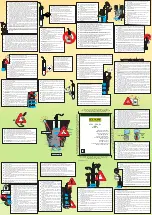
5
2.1 Driving End
The structure of metering pump driving end has 3 functions: First one is the retarding transmission; second one
is conversion of dynamic form; third one is the adjustment of crank radius rotation. It’s a retarding mechanism
constituted by worm and worm gears, and achieves dynamic retarding transmission. The crank-link mechanism
constituted by eccentric wheel, connecting rod and crosshead hinge completes the transition from rotation to
reciprocation. Sliding shaft, sliding shaft pin, adjusting screw rod, adjusting screw nut, scale-plate and adjusting
handle constitute
crank rotation radius adjusting mechanism. Parts of this 3 functions are bulked in the
transmission case to form driving end.
The structure of driving end is shown in Figures 2.
Working principal:
The working principle of retarding transmission and power conversion is that high speed rotary motor shaft
makes use of elastic coupling to transmit torque. Then it will slow down by worm and worm wheel. Rotation of
worm wheel is to drive worm-wheel shaft. The eccentric gear and its constituted crank-link mechanism turn the
rotation movement to crosshead straight reciprocating motion.
Crank rotation radius adjusting mechanism: To adjust the hand wheel manually, then the adjusting
screw rod will be rotated into adjusting screw nut
,
it then drives the linear displacement of sliding
shaft (N shaft). The both ends of sliding shaft pin are installed in the
eccentric gear, a
nd the middle end
is covered inside the skewed slots of sliding axial. With the linear displacement of sliding axial, the
sliding shaft pin will drive the
eccentric gear
for linear movement. No matter the metering pump is in
downtime or revolving, it can change the radius of gyration, thus to change the stroke length of
crosshead (plunger). The pointer and scale plate move relatively. The location showing by the pointer
can display the relative stroke length % in the scale plate.








































